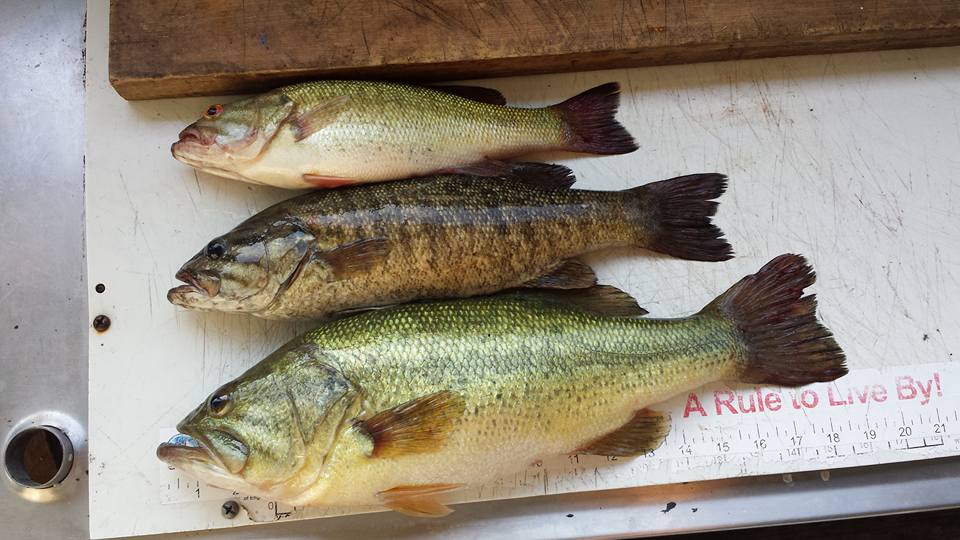Alex's recent catch! 13" kentucky, 15" small mouth, and a 18 1/2" large mouth. All the black bass!
Fred's recent fishing report.
The absence of fishing reports has been largely due to my absence from being on the lake, but with the help of those who have the time to test the waters, I’m able to give some information current to the times.
The summer is upon us in blazing intensity and has raised the lake’s surface temps to the mid to lower 80’s. The divers have reported the thermocline to begin about 17 feet down with an increasing coolness until they reach about 20 feet after which the water temp is constant at about 55 degrees. The clarity above the thermocline varies with the location around the lake with the deeper waters along the bluffs generally being clearer than along the more gradual slopping banks.
The results of these facts become evident when fishing with deep diving crank baits or pig’n’jig type lures along the chunk rock banks where the incline is running near 35 degrees or more. Some of the better fishermen have been bouncing deep cranks along the bottom while sitting in water more than 40 feet deep and finding better than average Small Mouth Bass hitting about the time the lure stops hitting the bottom and dives free of the rocks. Similar hits have occurred on the jig baits when the lures reach the top of the thermocline. Since summer Walleye tend to run in the upper level of the thermocline, there have been some 4 to 7 pound trophies taken in that zone.
If sleep is secondary and early morning top water is your goal, then be out there at least a half hour to an hour before sunrise is forecast and position yourself at the primary points of the major coves or feeder arms and wait! You’ll likely hear them before yo see them as the bass begin chasing the bait fish to the surface. This pattern can last from a quarter to a full hour depending on your luck but when all surface action has stopped, have a spoon ready to cast into the areas where the greatest activity occurred. Let the spoon fall for 6 to 8 seconds on a ¾ ounce spoon and it will drop to the lower part of the thermocline. If a fish hasn’t hit it on the fall, retrieve it in short jerks back to you and repeat. Many of the best fish will be beneath the smaller fish that were at the surface and surprises await the patient angler. Good luck and let me know how you do. Ed Cerar and Shannon Loveall have been helpful as well as making me envious.
The absence of fishing reports has been largely due to my absence from being on the lake, but with the help of those who have the time to test the waters, I’m able to give some information current to the times.
The summer is upon us in blazing intensity and has raised the lake’s surface temps to the mid to lower 80’s. The divers have reported the thermocline to begin about 17 feet down with an increasing coolness until they reach about 20 feet after which the water temp is constant at about 55 degrees. The clarity above the thermocline varies with the location around the lake with the deeper waters along the bluffs generally being clearer than along the more gradual slopping banks.
The results of these facts become evident when fishing with deep diving crank baits or pig’n’jig type lures along the chunk rock banks where the incline is running near 35 degrees or more. Some of the better fishermen have been bouncing deep cranks along the bottom while sitting in water more than 40 feet deep and finding better than average Small Mouth Bass hitting about the time the lure stops hitting the bottom and dives free of the rocks. Similar hits have occurred on the jig baits when the lures reach the top of the thermocline. Since summer Walleye tend to run in the upper level of the thermocline, there have been some 4 to 7 pound trophies taken in that zone.
If sleep is secondary and early morning top water is your goal, then be out there at least a half hour to an hour before sunrise is forecast and position yourself at the primary points of the major coves or feeder arms and wait! You’ll likely hear them before yo see them as the bass begin chasing the bait fish to the surface. This pattern can last from a quarter to a full hour depending on your luck but when all surface action has stopped, have a spoon ready to cast into the areas where the greatest activity occurred. Let the spoon fall for 6 to 8 seconds on a ¾ ounce spoon and it will drop to the lower part of the thermocline. If a fish hasn’t hit it on the fall, retrieve it in short jerks back to you and repeat. Many of the best fish will be beneath the smaller fish that were at the surface and surprises await the patient angler. Good luck and let me know how you do. Ed Cerar and Shannon Loveall have been helpful as well as making me envious.



 RSS Feed
RSS Feed